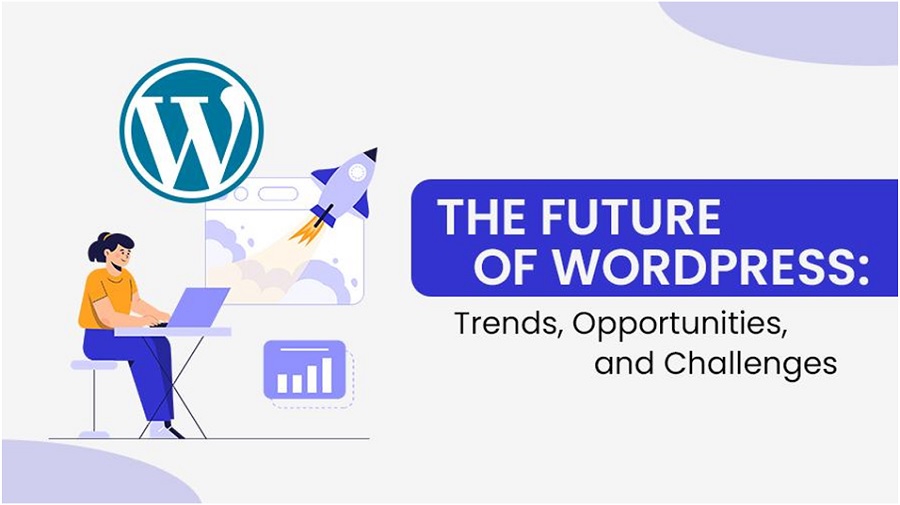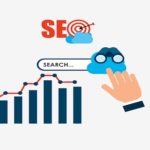The Future of WordPress: Trends, Opportunities, and Challenges

WordPress stands as an exemplary symbol of adaptability and innovation in web development and content management, rising from its humble blogging beginnings all the way up to being featured as part of over 40% of websites worldwide today. In the realm of WordPress development, there’s a constant evolution to meet user demands and adhere to evolving standards of usage. WordPress continues to meet ever changing user requirements as it continually develops to meet them all – currently over 40% use it regularly! Looking ahead, trends, opportunities, and challenges that promise to radically reimagine its experience are rapidly developing on our horizon – promising an innovative WordPress experience that redefines experience across various sectors including developers, business owners, content creators alike!
Evolution of WordPress
————————————
WordPress has come a long way since its initial debut as an exclusive blogging platform back in 2003. Today, its capabilities have expanded greatly into an expansive CMS capable of powering both personal blogs and large corporate sites. Its evolution can be traced to open-source principles, user-friendly design features and an abundance of themes and plugins which enhance functionality.
Current State of WordPress
WordPress remains one of the top CMS options due to its flexible nature, ease of use and active community. As its market share steadily expands across industries and users’ ability to quickly learn its features demonstrates, WordPress stands out as an adaptable CMS suitable for websites of all sizes – offering both novice users and veteran developers alike with an accessible solution that suits both roles perfectly.
Emerging Trends in WordPress
————————————
WordPress continues to change with technological advancement, evolving user expectations, and the needs of an increasingly digital economy. This change is marked by several emerging trends which will define its future; let’s delve deeper into these opportunities that they present within the WordPress ecosystem.
- eCommerce Integration: WordPress has quickly become one of the premier eCommerce platforms with the rise of online shopping, thanks to WooCommerce and other eCommerce plugins. WooCommerce transforms any WordPress website into a fully functioning online store through WooCommerce’s plugin; users are then able to sell physical and digital products, manage inventory/shipping/payment processing directly on their WordPress site using this integration – offering new opportunities for businesses of all sizes to quickly set up eCommerce operations using its ease-of-use and extensibility features.
- Headless WordPress: Another trend gaining steam is using WordPress as a headless CMS, or “headless WP.” In such an arrangement, WordPress serves as the back-end content management system while the front end is provided by technologies like static site generators or modern JavaScript frameworks such as React or Vue.js. This separation enables more flexibility when it comes to how content is presented and delivered resulting in faster websites with improved security features as well as the creation of more dynamic user experiences similar to an app-like user journey. Headless WP offers a powerful solution which leverages WordPress’s robust content management capabilities while not being bound by its traditional presentation layer constraints – providing businesses looking to build complex web apps headless WordPress offers a powerful solution with great potential at harnessing all its robust capabilities without its traditional presentation layer limitation!
- Gutenberg and Block Editor: Gutenberg represents an enormous leap forward for content creation on WordPress. Since it debuted with version 5.0, Gutenberg has replaced the classic editor with an intuitive block-based system enabling users to easily design pages using blocks for text, images and video – perfect for rapid page building without extensive coding expertise! And its continuing development – with regular updates adding new blocks and capabilities – ensures WordPress remains user-friendly while remaining adaptable enough for complex design requirements.
Opportunities in the WordPress Ecosystem
————————————
- Themes and Plugins Development: As businesses and individuals look to enhance their websites’ functionality with unique themes and plugins for WordPress websites, developers have seen demand grow exponentially for custom solutions or personalized development services that utilize this open-source CMS. Developers now have ample room for innovation – crafting themes and plugins tailored specifically towards niche markets while improving user experiences or even adding cutting edge technologies into WordPress development projects. This creates significant opportunities for them.
- WordPress as a Learning Platform: WordPress’s flexibility and usability has made it an attractive platform for educational websites and courses online, including classes taught via online video conferencing systems like LearnDash or LifterLMS. Utilizing plugins such as LearnDash or LifterLMS enables WordPress to function as a learning management system (LMS), enabling educators and trainers to easily develop, manage, sell courses online – creating opportunities for developers creating educational content as well as custom LMS solutions or offering professional services to educational institutions or professionals seeking to broaden their online presence online.
- Services and Consultancy: As WordPress continues its rapid evolution, more expert services in areas like website design, performance optimization, security and SEO have become essential components. Professionals in these fields may find lucrative consulting opportunities with businesses or individuals looking to maximize the potential of their WordPress site. Furthermore, headless WordPress integration opens new vistas of front-end development API integration as well as retail consultancy consultancy opportunities for professionals specializing in these areas.
Challenges Facing WordPress
————————————
Though WordPress remains one of the premier content management systems available today, its rise hasn’t come without challenges. These obstacles come from widespread adoption, open-source nature of the platform and rapidly developing digital landscape. Overcoming such difficulties is integral for maintaining its position as leading platform for web development and content management.
1. Security Concerns
One of WordPress’ most pressing challenges is security. Due to its widespread adoption, websites created using it often become targets of hackers and other forms of attack due to being open-sourced – thus giving access to any and all with malicious intentions who access its code directly. Vulnerabilities may arise within its core platform itself or from poorly maintained plugins and themes; updates and patches may be released regularly in response, although website administrators must apply these updates immediately given how large numbers of WordPress sites remain vulnerable due to outdated software or weak passwords.
2. Performance and Scalability
As websites grow in content and traffic, performance and scalability become key concerns. WordPress with its vast library of plugins and themes may experience database bloat, slow page loads times and server strain in high traffic conditions; compounded further by shared hosting environments which host many WordPress websites; optimizing WordPress for high performance often requires technical skills in areas like caching management databases management content delivery networks that may be beyond the capabilities of most users.
3. Plugin and Theme Quality
WordPress’s vast ecosystem of plugins and themes is one of its greatest assets, yet also poses considerable challenges. With thousands of extensions available for purchase, their quality and security may differ greatly – some being poorly coded, no longer maintained, incompatible with new versions of WordPress or plugins installed, leading to security vulnerabilities, website crashes or performance issues that compromise both business continuity. Users must carefully vet plugins and themes, relying on reviews, developer reputation, and update history to make informed choices.
4. Competition from Website Builders
WordPress faces increasing competition from hosted website builders such as Squarespace, Wix and Shopify – platforms with user-friendly interfaces and drag-and-drop website building features that offer ease-of-use such as drag-and-drop site creation – who offer user-friendly drag-and-drop site creation capabilities and integrated hosting solutions – offering enhanced hosting solutions and easier website building features such as drag-and-drop site building capabilities. These websites appeal to people searching for simplicity. While WordPress remains more flexible and powerful, the learning curve and ongoing maintenance requirements can drive non-technical users towards these more straightforward alternatives. WordPress must continue to innovate and simplify its user experience to remain competitive.
The Future of WordPress
————————————
Future success of WordPress relies on its capacity for innovation and adaptation, specifically through integration of emerging technologies like Artificial Intelligence (AI) and Machine Learning (ML). Such technologies promise transformative potential for optimizing WordPress functionalities across content creation and optimization to user experience optimization and site administration – let’s dive deeper into expected innovations and improvements within WordPress as well as AI/ML’s role here!
Innovations and Improvements in WordPress
As WordPress evolves, we can expect significant advances aimed at making its platform easier to use and more flexible – these innovations may focus on several areas like:
- User Experience (UX): Enhancements to user experience (UX) remain top of mind, with an aim of making WordPress even more user-friendly while offering advanced features to experienced developers. This involves improving Gutenberg editor performance, streamlining site customization processes and increasing overall workflow within WordPress dashboard.
- Full Site Editing: Full site editing represents an exciting step forward from Gutenberg, offering users unprecedented control and flexibility over every element of their site’s design directly within WordPress interface. This feature has the power to democratize web design further – even those without advanced technical experience can create fully customized sites using this revolutionary new approach!
- Performance Optimization: As web standards and user expectations change, WordPress should incorporate more tools for performance optimization within itself, including improved handling of images and videos as well as tighter integration between caching solutions and content delivery networks (CDN) to guarantee fast load times worldwide.
- Security Enhancements: WordPress will likely tighten up its security measures in response to increased cyberthreats, with improved core measures, monitoring tools and simpler integration with third-party plugins or services likely on offer.
The Role of AI and Machine Learning
————————————
AI and machine learning (ML) technologies promise to revolutionize WordPress in several ways, offering visitors smarter web experiences than ever. AI and machine learning (ML) technologies hold immense promise to transform WordPress in multiple ways, offering visitors more intelligent web experiences than ever. Here are several areas in which these developments could make an impactful statement about them:
- Content Creation and Optimization: Artificial Intelligence-powered tools can assist with content production by brainstorming content ideas, optimizing SEO rankings and writing drafts. Machine Learning algorithms can analyze large volumes of data to suggest content strategies likely to engage audiences while ranking well on search engines.
- Personalization: AI technology enables dynamic content personalization by adapting what visitors see to their behaviors, preferences and past interactions – with such levels of customization increasing user engagement while increasing time spent browsing onsite and driving up conversion rates.
- Image and Video Management: AI technology enables automated optimization of images and videos for faster loading times, improved SEO rankings and accessibility purposes. This includes automatic resizing, compression and generation of alt texts using image recognition technologies.
- Security: Artificial Intelligence and Machine Learning technologies can bolster WordPress security by rapidly detecting and responding to any threats in real-time. Machine Learning algorithms can recognize patterns indicative of malicious activity – like brute force attacks or unusual login attempts – before taking preemptive steps to secure their sites.
- Customer Support and User Experience: Chatbots and AI-driven support tools can enhance user experiences by offering instant assistance and guidance, helping to navigate platforms more smoothly, solve issues more swiftly, and locate information more rapidly.
Conclusion
WordPress’s future promises dynamic growth and innovation, spurred on by such trends as Gutenberg editor, headless CMS integration and AI implementation; which are revolutionizing web development while elevating user experiences. Opportunities abound for theme and plugin developers, eCommerce businesses, educators, and education institutions backed by vibrant communities; yet security threats, performance optimization needs and competition from website builders remain obstacles that need addressing. WordPress remains an open-source, adaptable platform despite any hurdles it might face, positioning itself for continued success in today’s digital environment. In essence, its open nature and adaptability positions it as one of the cornerstones of web technology; constantly adapting to changes and shaping future content creation and management techniques.




